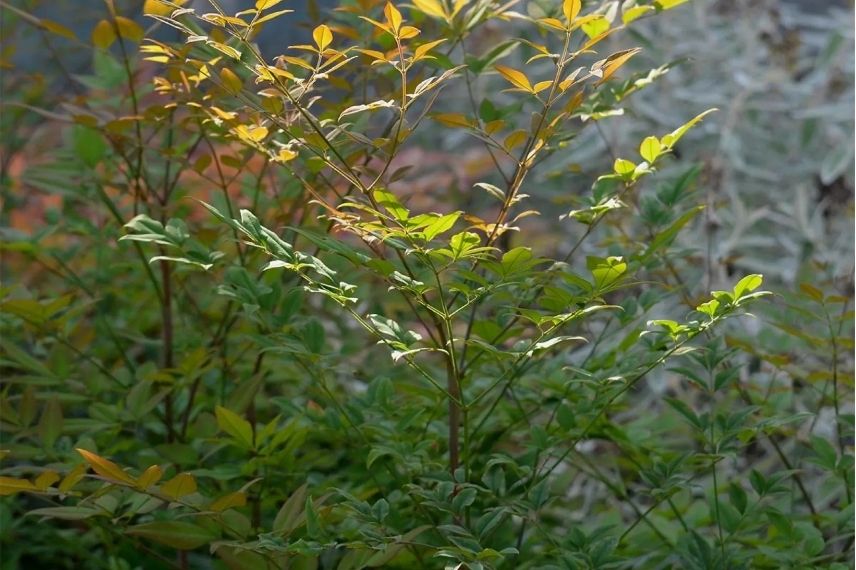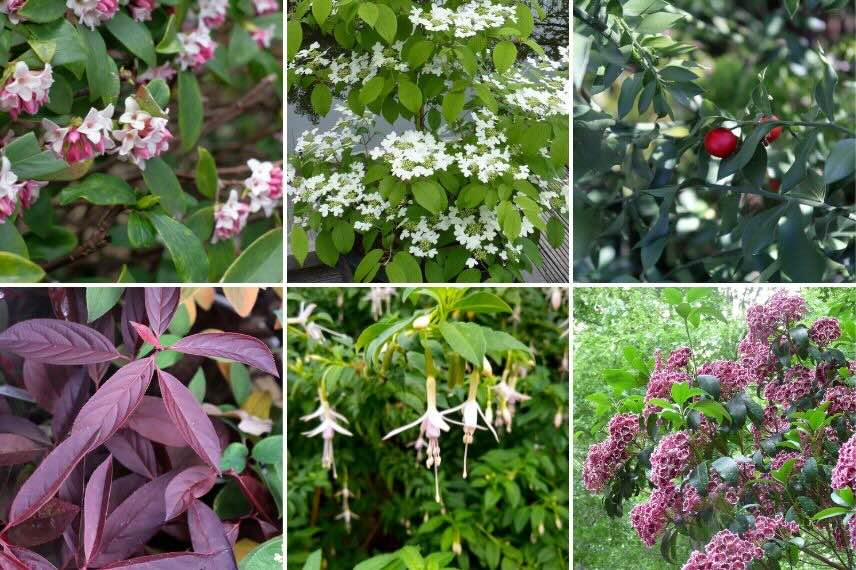
The best shrubs for partial shade: our selection
and our planting advice
Contents
Partial shade is often perceived as a constraint in gardening, but in reality, it offers an ideal balance for many bushes. Some plants don’t just survive there: they reveal their full beauty by developing denser foliage, longer-lasting flowering, or better resistance to soil conditions.
Under trees, at the edge of woodland, or along a wall receiving only a few hours of sunlight per day, choosing the right bushes allows for a well-structured and low-maintenance garden. From evergreen species with spectacular flowering to those suited to dry or moist soil, there are solutions for every situation.
In this article, discover a selection of the best bushes for partial shade, along with practical tips for planting and caring for them to optimise their growth and flowering.
Understanding partial shade exposure and its specifics for bushes

Partial shade is characterised by a few hours of direct sunlight per day, in the morning or afternoon, or by filtered sunlight. Here, a Nandina domestica
The best bushes for partial shade exposure
Evergreen Bushes for Year-Round Structure
Ilex aquifolium ‘JC Van Tol’: this holly forms a large, thorny bush with glossy green foliage. Its white flowers produce small, spherical, bright red berries from October to March, highly decorative. It thrives in neutral, fresh, well-drained soil. In partial shade, its foliage is denser and shinier than in direct sunlight. Perfect for hedges, standalone planting, or mixed with other bushes. Note that variegated forms of common holly prefer more sun.
Daphne odora: this small evergreen bush is cherished for its enchanting fragrance in late winter, with pink clustered flowers. It prefers well-drained, neutral to slightly acidic soil, without waterlogging. In partial shade, its flowering lasts longer, and its foliage is more vibrant than in full sun, where it may struggle. Ideal for borders near pathways to enjoy its scent.
Leucothoe fontanesiana ‘Scarletta’: its evergreen foliage changes colour with the seasons—green in spring, purple in autumn, and scarlet red in winter. It thrives in fresh, acidic soil and finds the perfect balance of light and moisture in partial shade. Used as ground cover, in beds, or containers. It can also grow in full shade, but its colours are more striking in partial shade.
Bushes with Striking Flowering in Partial Shade
Shrubby Fuchsias: bushes with stunning pendulous bell-shaped flowers, giving them a Japanese-inspired look. Most shrubby fuchsias are hardy and return faithfully each year, sometimes growing into large bushes. They prefer fresh, well-drained soil.
Kalmia latifolia: also called “mountain laurel”, it produces magnificent white, pink, or reddish umbel flowers in spring. It thrives in fresh, acidic soil, and its flowering is more spectacular in partial shade than in full sun, where heat may stress it.
Viburnum plicatum ‘Kilimanjaro’: this deciduous bush is prized for its spectacular tiered flowers in spring and its fiery red autumn foliage. It thrives in neutral to slightly acidic, fresh, rich soil and prefers partial shade, where its flowers remain vibrant longer.
Stewartia pseudocamellia: this stunning summer-flowering bush produces white flowers resembling camellias, followed by orange-red autumn foliage and peeling bark, highly decorative in winter. It prefers rich, fresh soil and grows best in bright partial shade.
Bushes for Dry Soils in Partial Shade
Ruscus aculeatus: also called butcher’s broom, this evergreen bush is perfect for dry, shaded areas. Its tough foliage and red winter berries make it an excellent decorative bush for dry woodlands and gardens where few bushes survive.
Nandina domestica: this bush thrives in partial shade, sheltered from wind, and in moderately dry soil. It offers delicate, colourful foliage in autumn and light white flowering followed by red berries. Ideal for borders, beds, or standalone planting.
Rhamnus alaternus ‘Argenteovariegata’: its silvery foliage brightens partial shade, and this low-maintenance bush tolerates dry soil well. Its white-variegated leaves, discreet but fragrant spring flowering (melliferous), are followed on female plants by pretty red berries turning black at ripeness.
Bushes for Chalky Soils and Partial Shade
Japanese Spindle: Latin name Euonymus japonicus, this is a reliable bush well-suited to chalky soils, with evergreen foliage, ideal for hedges, groves, screens, pots, and coastal gardens. It prefers partial shade and comes in many variegated or golden-leaved varieties.
The butcher’s broom, mentioned above for dry soils, also tolerates chalky soils, as does the Snowberry, a deciduous bush with pretty white or pink berries.
Bushes for Moist Soils in Partial Shade
Many options in this category, such as Astilbes, Cornus sericea, or Itea virginica.

Clockwise: Daphne odora, Viburnum plicatum ‘Kilimanjaro’, Ruscus aculeatus, Kalmia latifolia ‘Keepsake’, Fuchsia magellanica, Itea virginica ‘Henry’s Garnet’
Planting and care tips for thriving partial shade bushes
- Subscribe!
- Contents

































Comments